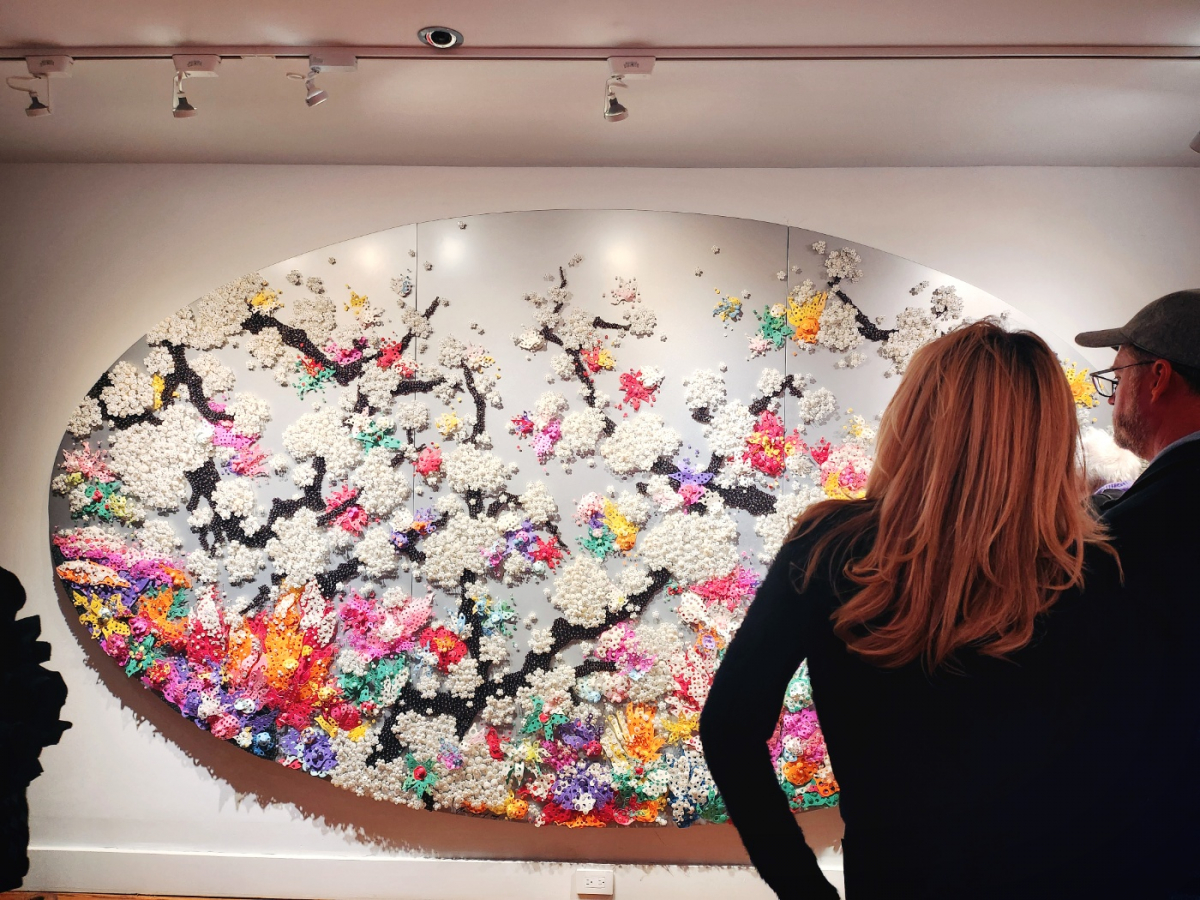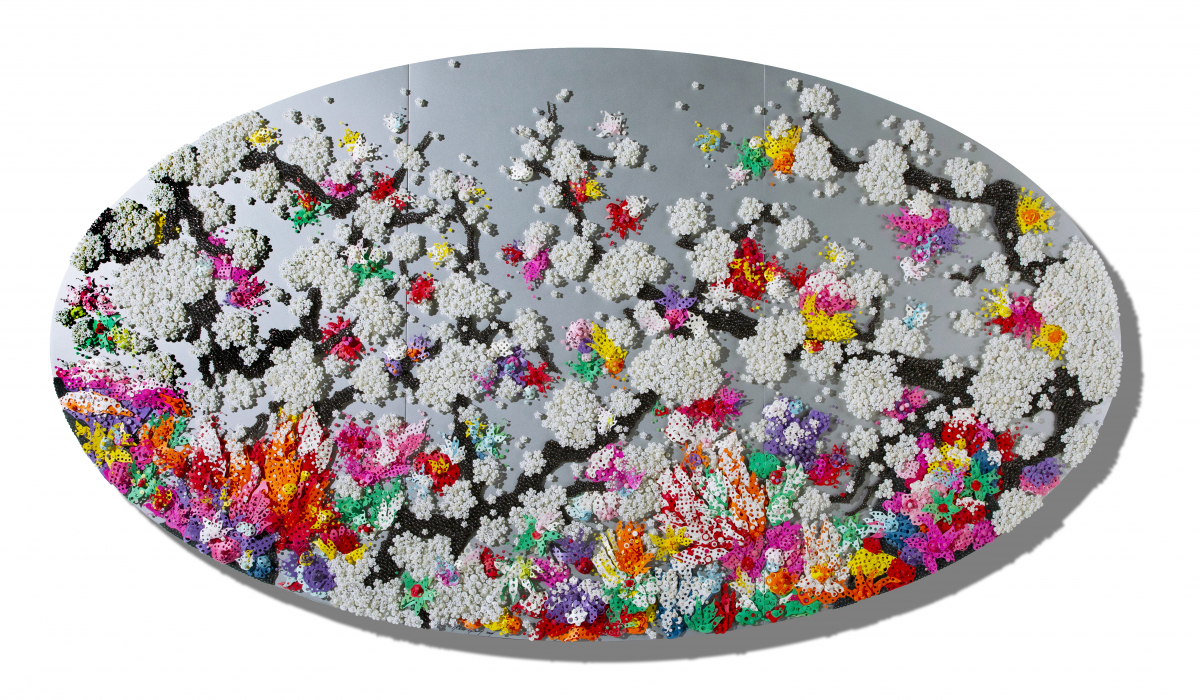
Ran Hwang: Evanescence & Regeneration
Leila Heller Gallery
10/15 – 12/7/2024
Leila Heller Gallery presents Evanescence & Regeneration, a site-specific exhibition of nineteen new works by Korean artist Ran Hwang that explores traditional forms and themes of Asian culture and art in a highly charged presentation with links to the décor field. Hwang's connection to the imagery of plum blossoms, an almost national treasure in Asia, is articulated by beads, pins, paper, buttons, and nails, which have played a key role in Hwang's work-intensive process for some time. The blossoms signal that life is renewing itself in splendor. They are one of the Chinese "Three Friends of Winter" springing from branches that appear dead. They are among the four flowers that represent a season: Spring. The five petals of the plum blossom stand for the "Five Gods of Good Luck." Hwang's affinity for this flowering tree integrates aspects of symbolism and craft as she hammers pins and nails into paper buttons to affix them in multitudes on shaped plexiglass or wooden surfaces.
The artist immerses herself in the creative process as she strives for a material expression that fulfills her vision and needs to replicate a volumetric aspect of nature. The intricate particles adhere on translucent ultra-modern plexiglass surfaces. She covers a wood foundation with silver metallic paint that suggests machine veneers. Floral petals are amassed into blossoms over the background spaces.

Shape plays a major contributory role in Hwang's art. She uses circular forms symbolically to denote the eternal character of round formats. In the "Ode to the Full Moon," she plays with cycles of unexpected color: bright greenish blue, glittering pink, pale green, and neutrals of black, white, and gray. In this multiplex piece, these cycles speak to the artist's intensive constructive work process, as she creates alterations with new views that are subtly diversified. Except for these few examples, where the flowers take on a bright hue, the blossoms remain, for the most part, white, surrounded by the rough texture of the brown trunks and branches.
Hwang eases into the realm of "Décor" in some of her pieces. The blue screen is an example of a traditional Asian screen with updated variations; these are usually composed of panels delicately covered with water-based paints or inks on paper. Hwang reinterprets this style imaginatively to make the expressive statement stronger, more brightly colored, and surprisingly playful. The striking panels allude to contemporary interiors with the galaxy-like flowers that invoke stars in a vibrant evening sky. Nature here is assertively stated and more boldly expressed.
In "Beyond the Serenity," the entire work is immersed in solid pink, and in "Beyond the Serenity _P," 2024, the piece is saturated in a deeper orange-pink, which has isolated the blossoms in an unvaried world of pink hue. Pink subtly alludes to popular contemporary fashion. The oval shape of "Healing the Oblivious Aqua_OS," 2024, imitates a horizontal landscape format with softened edges. The silver metallic background vibrates with the nails and pins, juxtaposing them with a field of colorful primary hues in the bunched and blown petals. In this work, the artist expands her vocabulary to display a video game quality with pieces of plastic and paper blossoms juxtaposed with the silver ground. Nature is no longer pure or precious; it has become an extension of leisure that is adjoined to life's daily diversions and pleasures. It has become something that is fun to see and think about in leisurely contemplation but is not to be taken overly seriously or imbued with emotions or imaginative narratives. Nature is becoming more ordinary in popular culture.

Hwang acts on an inner drive that seems to compel her to hammer materials in place on the surfaces and to shape those surfaces in symbolic ways that imply segments of experience as much as the fullness of expression.
Hwang has spanned the domain of traditional screens, wall hangings, and panels by expanding to ovals, circles, and extra-narrow formats. The artist has been fastidious in her work, hammering prolifically to deconstruct the image and conception of the Asian woman, which is often compared metaphorically to the traditional national flower. Whether consciously or without a clear sense of awareness, the artist is pounding away to undermine the cliché of delicacy whose aura plagues contemporary Asian women. They are in every way anxious to succeed in careers in contemporary art, business, finance, and all arenas of achievement and excellence. The works, including the steel nails embedded in the midst of the flower petals, retain their character with the addition of metal centers to affix them in place, within their firmament of purity in the context of reinterpretation, renewal, and redefinition.
Ran Hwang's powerful yet semi-decorative works express a strong self-assertive link with interior décor. She succeeds in imbuing her solid pink and pink/orange circular formats with a compelling volumetric depth of field that retains viewer interest as it fixes the eye on the dramatically shaped structures. The blend of natural petals and mechanistic nails and pins creates an unexpected, enigmatic combination that asks more questions than it answers. There is a tension at play in the works, in the forceful aura of contrasting elements that hold the viewer's attention. The unusually strong personal take on nature in the exhibition is both rewarding and stimulating. Ran Hwang has integrated Asian spiritual motifs and traditional Asian Interior décor with a trendy take on pop-Western nature perspectives to create an emphatic blend of forces that stir and inspire the viewer.
